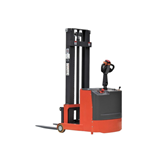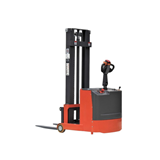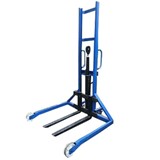In today's fast-paced logistics industry, the efficient handling and movement of shipping containers are of utmost importance. One essential piece of equipment that plays a crucial role in container handling operations is the reach stacker. Whether you are a port operator, a warehouse manager, or involved in any business that requires container stacking and transportation, this ultimate buying guide will provide you with valuable insights to help you make an informed decision when purchasing a reach stacker.
Containerized shipping has revolutionized the global trade industry, enabling efficient and secure transportation of goods across long distances. Reach stackers are specifically designed to handle shipping containers in various environments, such as ports, intermodal yards, and warehouses. These versatile machines offer exceptional lifting capacity and maneuverability, making them a popular choice for container handling operations.
What is a Reach Stacker?
A reach stacker is a specialized piece of heavy machinery used for lifting, moving, and stacking ISO standard shipping containers. Unlike forklifts, reach stackers are specifically designed for handling containers and have the capability to stack containers up to several heights. They typically feature a telescopic boom and a set of hydraulic spreader arms to securely grip and lift containers.
Reach Stackers: Types and Their Uses in Material Handling
In the realm of material handling and logistics, reach stackers have become indispensable machines for efficiently moving and stacking heavy loads, particularly shipping containers. Reach stackers are designed to handle containers in various environments, such as ports, warehouses, and intermodal yards. This article will delve into the different types of reach stackers available in the market and explore their specific uses in material handling operations.
1. Electric Reach Stackers
Electric reach stackers are powered by electric motors and utilize rechargeable batteries as their energy source. They have gained popularity due to their eco-friendly operation, producing zero emissions and lower noise levels compared to their diesel counterparts. Electric reach stackers are particularly well-suited for indoor or enclosed spaces where emissions and noise pollution need to be minimized. These machines offer excellent maneuverability and are often preferred in environments that prioritize sustainability and compliance with environmental regulations.
Uses of Electric Reach Stackers
- Container handling in warehouses and distribution centers with strict emission standards.
- Efficiently moving and stacking containers in industrial facilities located near residential areas.
- Safe material handling in environmentally sensitive areas such as ports and terminals.
2. Diesel Reach Stackers
Diesel reach stackers, as the name suggests, are powered by diesel engines. They are known for their high torque, lifting capacity, and ruggedness, making them suitable for heavy-duty applications and outdoor operations. Diesel reach stackers are commonly employed in large port terminals and open yards where power supply infrastructure may be limited. These machines offer superior lifting capabilities and are often chosen for their ability to handle heavy loads and navigate rough terrains.
Uses of Diesel Reach Stackers
- Efficient container handling in busy port terminals with high container traffic.
- Stacking containers in intermodal yards where reach stackers need to operate on unpaved or uneven surfaces.
- Handling heavy loads and oversized containers in demanding industrial environments.
3. Hybrid Reach Stackers
Hybrid reach stackers combine the benefits of electric and diesel reach stackers by incorporating both electric and combustion engine components. These machines feature a rechargeable battery pack that works in conjunction with a diesel generator. Hybrid reach stackers offer reduced fuel consumption and emissions compared to traditional diesel reach stackers, while still providing the power and versatility required for heavy-duty material handling operations.
Uses of Hybrid Reach Stackers
- Hybrid reach stackers are ideal for environments that require a balance between power and environmental sustainability.
- Handling containers in ports and terminals with varying emission standards and regulations.
- Efficiently stacking and transporting containers in intermodal yards with a mix of indoor and outdoor operations.
4. Specialized Reach Stackers
Apart from electric, diesel, and hybrid reach stackers, there are specialized reach stackers designed to cater to specific material handling needs. These specialized reach stackers offer unique features and functionalities to address specific challenges in various industries. Some examples include:
Laden Reach Stackers
Laden reach stackers are specifically designed to handle loaded containers. They are equipped with advanced load monitoring systems and reinforced structures to ensure safe and efficient handling of heavy loads.
Empty Container Reach Stackers
Empty container reach stackers are optimized for stacking and moving empty containers. They are often lighter and more agile, allowing for higher stacking capabilities and faster cycle times.
Intermodal Reach Stackers
Intermodal reach stackers are designed to handle containers that require seamless transportation across different modes, such as trucks, trains, and ships. These reach stackers have specialized lifting attachments and enhanced mobility features to facilitate efficient intermodal operations.
10 Key Factors to Consider When Buying a Reach Stacker
Investing in a reach stacker requires careful consideration to ensure that you select the right machine for your material handling needs. Here are ten key factors to keep in mind when buying a reach stacker:
1. Capacity and Lift Height
Determine the maximum weight of containers you need to handle and ensure that the reach stacker has the lifting capacity to meet your requirements. Additionally, consider the maximum stacking height needed for your operations. Some reach stackers can stack containers several layers high, providing greater flexibility and optimizing storage space.
2. Application and Industry Requirements
Different industries and applications have specific requirements when it comes to reach stackers. Consider factors such as the type of cargo you handle, the frequency of container movements, and any unique operational challenges you may encounter. For example, if you operate in a port with heavy container traffic, you might prioritize a reach stacker with excellent maneuverability and fast cycle times.
3. Fuel Type and Emissions
The choice between electric and diesel reach stackers depends on your environmental objectives, operating conditions, and local regulations. Electric reach stackers offer the advantage of zero emissions and lower noise levels, making them environmentally friendly and suitable for indoor or urban areas with strict emission standards. Diesel reach stackers, on the other hand, provide higher power and are better suited for heavy-duty outdoor applications.
4. Maneuverability and Turning Radius
Efficient maneuverability is crucial for smooth container handling operations. Consider the reach stacker's turning radius and its ability to navigate tight spaces. A smaller turning radius allows for better maneuverability, enabling the reach stacker to operate in congested areas without compromising safety or productivity.
5. Maintenance and Serviceability
Regular maintenance is essential for the longevity and reliability of your reach stacker. Look for models that are designed for easy maintenance and have readily available spare parts. Opt for reach stackers from reputable manufacturers known for their excellent after-sales support and service network. This ensures timely repairs, minimal downtime, and maximum productivity.
6. Safety Features
Container handling involves inherent risks, so prioritize reach stackers with robust safety features. Look for features such as load monitoring systems, stability control, anti-slip technology, and operator safety cabins with excellent visibility. Safety should always be a top consideration to protect both your operators and the cargo being handled.
7. Cost and Budget Considerations
While it's important to consider the upfront cost of a reach stacker, it's equally crucial to evaluate the long-term return on investment (ROI). Consider factors such as fuel efficiency, maintenance costs, and potential productivity gains. Investing in a higher-quality reach stacker upfront may yield better performance, lower operating costs, and increased lifespan, providing a higher ROI over time.
8. Availability of Spare Parts
Ensure that the reach stacker you choose has a reliable supply of spare parts. Availability of spare parts can impact maintenance and repair timelines, so it's essential to select a model from a manufacturer with a strong distribution network and readily accessible spare parts.
9. Operator Comfort and Ergonomics
Operator comfort and ergonomics play a crucial role in ensuring productivity and reducing fatigue-related issues. Look for reach stackers that offer adjustable seating, ergonomic controls, and a well-designed operator cabin with ample visibility. Comfortable operators are more likely to perform efficiently and safely.
10. Reputation and Customer Reviews
Do thorough research on the reputation of the reach stacker manufacturer. Read customer reviews and testimonials to gain insights into the experiences of other users. A reputable manufacturer with positive customer feedback is more likely to deliver a reliable and high-quality reach stacker.
Slash Energy Costs with Your Reach Stacker: A Step-by-Step Guide
In today's competitive business landscape, optimizing operational costs is essential for the long-term success of any warehouse or port. Energy costs can be a significant portion of the overall expenses, especially when it comes to operating heavy machinery such as reach stackers. In this step-by-step guide, we will explore effective strategies to slash energy costs with your reach stacker, helping you achieve substantial savings while maintaining operational efficiency.
Step 1: Conduct an Energy Audit
Before implementing any energy-saving measures, it's crucial to conduct a comprehensive energy audit of your reach stacker operations. This involves assessing energy consumption patterns, identifying inefficiencies, and pinpointing areas where improvements can be made. By understanding your current energy usage and where energy is being wasted, you can develop a targeted plan to reduce consumption.
Step 2: Optimize Operator Training
Operator behavior plays a significant role in energy efficiency. Ensure that your reach stacker operators are well-trained in best practices for operating the equipment with energy conservation in mind. This includes minimizing unnecessary idling, using the appropriate lifting capacity for each load, and optimizing travel routes to reduce distance and time. Effective training can lead to substantial energy savings without compromising productivity.
Step 3: Regular Maintenance and Inspections
Proper maintenance of your reach stacker is essential for optimal performance and energy efficiency. Develop a proactive maintenance schedule that includes regular inspections, lubrication of moving parts, and timely replacement of worn-out components. Well-maintained equipment operates more efficiently, resulting in lower energy consumption. Additionally, address any leaks or air pressure issues promptly to prevent energy losses.
Step 4: Upgrade to Energy-Efficient Components
Consider upgrading certain components of your reach stacker to energy-efficient alternatives. For example, switching to LED lights can significantly reduce energy consumption compared to traditional lighting options. Similarly, investing in energy-efficient motors and advanced hydraulic systems can lead to substantial energy savings over time. Evaluate the potential return on investment for each upgrade and prioritize those that offer the greatest energy-efficiency benefits.
Step 5: Optimize Hydraulic System Settings
The hydraulic system of a reach stacker can be optimized to minimize energy usage. Consult with an expert or the manufacturer to adjust hydraulic settings such as pressure, flow rates, and response times. Fine-tuning these settings can help reduce unnecessary energy consumption without compromising the lifting capacity or operational performance of the reach stacker.
Step 6: Utilize Idle-Reduction Technologies
Idle time is a significant source of energy wastage in reach stacker operations. Implement idle-reduction technologies such as automatic engine shutdown during extended periods of inactivity. These technologies can be programmed to power down the reach stacker after a certain duration of idle time, conserving energy and reducing fuel consumption. Additionally, consider utilizing smart start-stop systems that automatically turn off the engine during short breaks or waiting periods.
Step 7: Implement Telematics and Data Analysis
Leverage telematics systems to collect real-time data on your reach stacker's energy consumption and operational parameters. Analyze this data to identify trends, patterns, and opportunities for further energy optimization. Telematics can provide valuable insights into idle times, load capacities, and fuel consumption, enabling you to make data-driven decisions and continuously improve energy efficiency.
Step 8: Regularly Monitor and Adjust
Energy-saving efforts should not be a one-time endeavor. Continuously monitor and analyze your reach stacker operations to identify new opportunities for energy efficiency improvements. Regularly review energy consumption reports, conduct follow-up audits, and engage with your operators to gather feedback and implement further optimizations. Consistent monitoring and adjustment will ensure that you stay on track towards achieving maximum energy savings.
Top Energy-Efficient Features to Look for When Buying a Reach Stacker
Are you in the market for a new reach stacker? As you explore the options available, it's essential to consider energy efficiency. By investing in a reach stacker with top energy-efficient features, you can not only reduce your environmental impact but also enjoy long-term cost savings. In this article, we will explore the key features to look for when buying a reach stacker that prioritizes energy efficiency.
1. Electric Power Source
One of the most significant energy-efficient features to consider is an electric power source. Electric reach stackers offer numerous advantages over their diesel counterparts. They produce zero emissions, minimizing environmental impact, and also provide quieter operation. Additionally, electric reach stackers tend to have lower maintenance costs, contributing to long-term savings.
2. Regenerative Braking System
An excellent energy-saving feature in a reach stacker is a regenerative braking system. This technology allows the stacker to recover and store energy that would otherwise be wasted during braking. By converting this energy into usable power, regenerative braking reduces energy consumption and improves overall efficiency.
3. Variable Speed Control
Reach stackers equipped with variable speed control can significantly enhance energy efficiency. This feature allows operators to adjust the speed based on the load and distance traveled, optimizing power usage. By reducing unnecessary acceleration and deceleration, reach stackers with variable speed control help conserve energy and extend battery life.
4. Efficient Hydraulic System
The hydraulic system of a reach stacker plays a crucial role in its energy efficiency. Look for stackers with advanced hydraulic systems that minimize energy loss and provide precise control. Efficient hydraulic systems reduce power consumption, resulting in overall energy savings.
5. LED Lighting
Though it may seem like a small detail, LED lighting can make a significant difference in the energy efficiency of a reach stacker. LED lights consume significantly less power than traditional lighting systems, reducing energy usage and extending battery life. Additionally, LED lights have a longer lifespan, reducing the frequency of replacements.
6. Energy Monitoring and Management Systems
To optimize energy efficiency, consider reach stackers equipped with energy monitoring and management systems. These systems provide real-time data on energy consumption, allowing operators to identify areas for improvement. By actively managing energy usage, you can make informed decisions that enhance efficiency and reduce operating costs.
Reach Stackers: New vs. Used – Which is the Best Option?
When considering whether to purchase a new or used reach stacker, there are several factors to take into account. Both options have their advantages and disadvantages, and the best choice depends on your specific circumstances and requirements. Let's explore the pros and cons of each option:
New Reach Stackers:
Pros:
- Reliability: New reach stackers come with the latest technology, components, and warranty, ensuring optimal performance and reliability.
- Customization: You have the flexibility to choose the specific features, attachments, and specifications that best suit your needs.
- Efficiency and Productivity: Newer models often incorporate advancements in fuel efficiency, ergonomics, and automation, which can enhance productivity and reduce operational costs.
- Longer Lifespan: With proper maintenance and care, new reach stackers generally have a longer lifespan than used ones, offering a higher return on investment in the long run.
Cons:
- Higher Cost: New reach stackers come with a higher price tag due to their newness, advanced features, and warranties.
- Depreciation: As soon as a new reach stacker is purchased, it starts to depreciate in value, which can affect its resale or trade-in value in the future.
- Limited Availability: Depending on the manufacturer and model, there might be waiting times for production and delivery, which can delay your acquisition process.
Used Reach Stackers:
Pros:
- Cost Savings: Used reach stackers are generally more affordable than new ones, allowing you to allocate your budget to other areas of your business.
- Immediate Availability: Unlike new reach stackers, used ones are readily available and can be quickly put into operation.
- Potential Bargains: If you find a well-maintained, low-hour used reach stacker, you may get a good deal, acquiring a reliable machine at a reduced price.
Cons:
- Limited Warranty: Used reach stackers typically come with shorter or no warranty, which means you may have to bear the repair and maintenance costs yourself.
- Uncertain History: Without thorough inspections or service records, there might be hidden issues or maintenance requirements that could lead to unexpected expenses.
- Technological Obsolescence: Older used reach stackers may lack the latest features, fuel efficiency, and automation capabilities, which can impact overall productivity and efficiency.
By thoroughly analyzing these factors and comparing the pros and cons of new and used options, you can make an informed decision that aligns with your budget, operational requirements, and risk tolerance. Ultimately, selecting the right reach stacker will contribute to efficient container handling operations and ensure a positive impact on your business.















